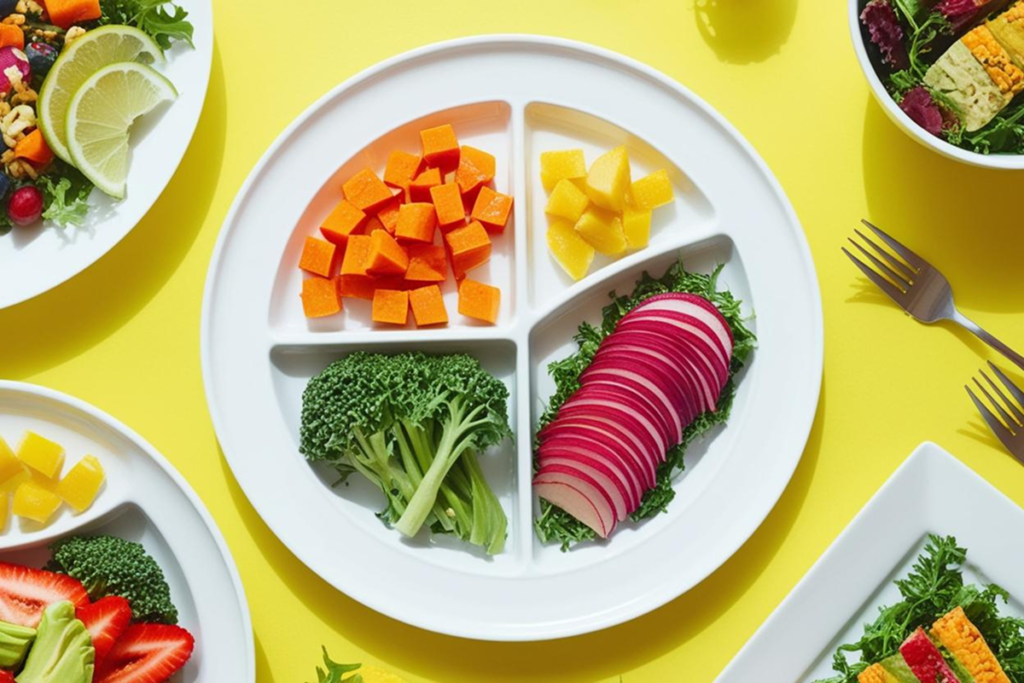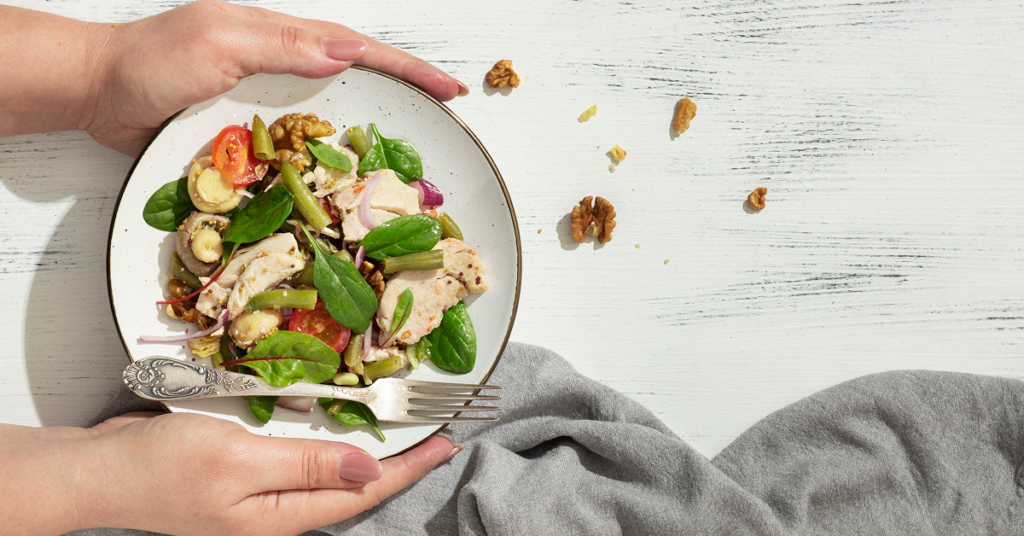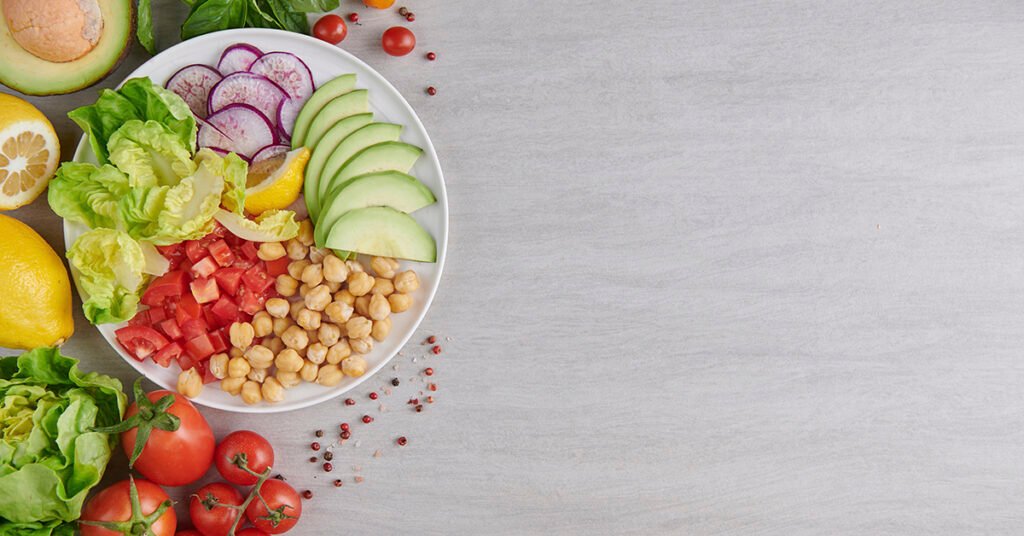Eating healthy isn’t about restrictive diets—it’s about balance! Knowing how to build a healthy plate ensures you get the right mix of macronutrients, vitamins, and minerals to fuel your body, boost energy, and support overall well-being. In this guide, you’ll learn how to structure a nutritious plate that helps you stay healthy and strong.
The Perfect Plate Formula

To create a balanced meal, aim for:
50% Vegetables & Fruits – These provide essential vitamins, minerals, and fiber, which support digestion, boost immunity, and promote overall health. Include a variety of colors to maximize nutrient intake. Fresh, frozen, or lightly cooked vegetables are best to preserve nutrients.
25% Protein – Lean meats, fish, tofu, beans, or legumes to support muscle growth and repair. Opt for grilled, baked, or steamed protein sources instead of fried options. Plant-based proteins such as lentils and chickpeas are excellent alternatives for vegetarians.
25% Whole Grains or Healthy Carbs – Brown rice, quinoa, sweet potatoes, or whole wheat products provide sustained energy, fiber, and essential nutrients. Whole grains are more nutrient-dense than refined grains, helping to regulate blood sugar levels and improve digestion.
Healthy Fats – Add avocado, nuts, seeds, or olive oil for essential fatty acids that support brain function, heart health, and cell repair. Choose unsaturated fats over saturated fats and avoid trans fats found in processed foods.
Color Your Meals
A colorful plate is a nutritious plate! Different colors in fruits and vegetables represent various antioxidants and nutrients that support overall health, protect against diseases, and enhance bodily functions. Eating a variety of colors ensures you get a diverse range of essential nutrients.
- Red (Tomatoes, Strawberries, Peppers, Watermelon) – Rich in antioxidants like lycopene, which support heart health and reduce inflammation.
- Green (Spinach, Broccoli, Avocado, Kale, Zucchini) – Packed with fiber, vitamins, and iron, aiding digestion, boosting immunity, and promoting healthy skin.
- Orange & Yellow (Carrots, Mangoes, Peppers, Sweet Potatoes, Pineapple) – High in vitamin C and beta-carotene, essential for vision, immune function, and skin health.
- Purple & Blue (Eggplant, Blueberries, Grapes, Plums, Blackberries) – Contain powerful antioxidants that support brain health, improve memory, and reduce the risk of chronic diseases.
- White & Brown (Cauliflower, Mushrooms, Garlic, Onions, Bananas) – Often overlooked, but they contain important nutrients like fiber, potassium, and anti-inflammatory compounds that support digestion and heart health.
Try incorporating a mix of these colors into your meals daily to ensure a well-rounded diet!
Portion Control Tips

Eating the right amount is just as important as eating the right foods. Try these simple portion control strategies:
- Use smaller plates to avoid overeating.
- Follow the hand guide: A palm-sized portion of protein, a fist-sized portion of carbs, and two handfuls of vegetables.
- Eat slowly and mindfully to recognize fullness cues.
- Avoid eating straight from the package to prevent mindless snacking.
Healthy Swaps for Better Nutrition
Small changes can make a big difference! Making simple swaps in your daily meals can significantly improve your overall nutrition and energy levels. Here are some easy and effective alternatives:
- Swap white rice for quinoa or brown rice to increase fiber intake and support digestion.
- Replace sugary drinks with water, herbal tea, or infused water to stay hydrated without added sugars.
- Choose Greek yogurt instead of flavored yogurts for more protein, probiotics, and fewer artificial additives.
- Use avocado or hummus instead of mayo to incorporate heart-healthy fats and add extra nutrients.
- Substitute whole grain bread for white bread to improve digestion and maintain steady energy levels.
- Swap baked or grilled proteins for fried options to cut down on unhealthy fats while keeping meals flavorful.
- Use spices and herbs instead of salt to enhance flavor without excess sodium.
These simple changes can help you make healthier choices without sacrificing taste or satisfaction!
Common Nutrition Mistakes to Avoid
Even with good intentions, some habits can hold you back:
Skipping meals – This can slow metabolism, cause energy crashes, and lead to overeating later in the day.
Not drinking enough water – Hydration is essential for digestion, circulation, and maintaining optimal energy levels. Aim for at least 8 glasses a day.
Relying on processed “healthy” foods – Many packaged foods labeled as “healthy” contain hidden sugars, preservatives, and artificial ingredients that can negatively impact your nutrition.
Ignoring protein intake – Protein is essential for muscle maintenance, satiety, and metabolic function. Incorporate a variety of protein sources, such as lean meats, fish, eggs, dairy, legumes, and nuts, to ensure balanced nutrition.
Eating too fast – Rushing through meals can prevent your body from recognizing fullness signals, leading to overeating. Try mindful eating by chewing slowly and savoring each bite.
Conclusion
Building a healthy plate is all about balance and variety. By including nutrient-rich foods, controlling portions, and making simple swaps, you can create meals that fuel your body and promote long-term wellness. Start small, stay consistent, and enjoy the benefits of a well-balanced diet!
Images: freepik



